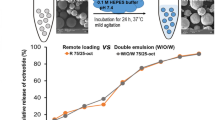Abstract
Purpose. We prepared injectable microspheres for controlled release of TAK-029, a water-soluble GPIIb/IIIa antagonist and discussed the characteristics of controlled release from microspheres.
Methods. Copoly(dl-lactic/glycolic)acid (PLGA) microspheres were used for controlled release of TAK-029 [4-(4-amidinobenzoylglycyl)-3-methoxycarbonyl-2-oxopiperazine-l-acetic acid]. They were prepared with a solid-in-oil-in-water (S/O/W) emulsion solvent evaporation technique using either a crystalline form or an amorphous form of the drug.
Results. An amorphous form of TAK-029 gave more homogeneous S/O dispersion and higher viscosity than its crystalline form when added to dichloromethane solution of PLGA, resulting in a high drug entrapment into microspheres and a well-controlled release of the drug. Additions of sodium chloride into an external aqueous phase and L-arginine into an oil phase also increased entrapment of the drug, and reduced initial burst of the drug from the microspheres. The micro-spheres demonstrated a desirable plasma level profile in therapeutic range (20−100 ng/ml) for 3 weeks in rats after single subcutaneous injection.
Conclusions. A well-controlled release of TAK-029, a water-soluble neutral drug, with small initial burst was achieved by utilizing its amorphous form as a result of possible interaction with PLGA and L-arginine.
Similar content being viewed by others
REFERENCES
L. M. Sanders, J. S. Kent, G. I. McRae, B. H. Vickery, T. R. Tice, and D. H. Lewis. J. Pharm. Sci. 73:1294–1297 (1984).
T. W. Redding, A. V. Schally, T. R. Tice, and W. E. Meyers. Proc. Natl. Acad. Sci. USA 81:5845–5848 (1984).
S. Takada, Y. Uda, H. Toguchi, and Y. Ogawa. PDA J. Pharm. Sci. Technol. 49:180–184 (1995).
C. Thomasin, P. Johansen, R. Alder, R. Bemsel, G. Hottinger, H. Altorfer, A. D. Wright, G. Wehrli, H. P. Merkel, and B. Gander. Eur. J. Pharm. Biopharm. 42:16–24 (1996).
Y. Ogawa, M. Yamamoto, S. Takada, H. Okada, and T. Shimamoto. Chem. Pharm. Bull. 36:1502–1507 (1988).
H. Okada, T. Heya, Y. Ogawa, and T. Shimamoto. J. Pharmacol. Exp. Ther. 244:744–750 (1988).
T. Heya, H. Okada, Y. Tanigawara, Y. Ogawa, and H. Toguchi. Int. J. Pharm. 69:69–75 (1991).
S. Takada, Y. Uda, H. Toguchi, and Y. Ogawa. J. Controlled Release 32:79–85 (1994).
The United States Pharmacopoeia, 23rd revision, Supplement 2, Rockville, USA, 1995, pp. 2697–2699.
H. Okada, M. Yamamoto, T. Heya, Y. Inoue, S. Kamei, Y. Ogawa, and H. Toguchi. J. Controlled Release 28:121–129 (1994).
J. W. Fong, J. P. Nazareno, J. E. Pearson, and H. V. Maulding. J. Controlled Release 3:119–130 (1986).
R. Bodmeier, and J. W. McGinity. Pharm. Res. 4:465–471 (1987).
R. Jalil, and J. R. Nixon. J. Microencapsulation 7:297–325 (1990).
M. Kawamura, Y. Imura, N. Moriya, S. Kita, H. Fukushi, H. Sugihara, K. Nishikawa, and Z. Terashita. J. Pharmacol. Exp. Ther. 277:502–510 (1996).
K. Peerlinck, I. De Lepeleire, M. Goldberg, D. Farrell, J. Barrett, E. Hand, D. Panebianco, H. Deckmyn, J. Vermylen, and J. Arnout. Circulation 88:1512–1517 (1993).
The EPIC Investigators. N. Engl. J. Med. 330:956–961 (1994).
S. Takada, T. Kurokawa, K. Miyazaki, S. Iwasa, and Y. Ogawa. Int. J. Pharm. 146:147–157 (1997).
G. Spenlehauer, M. Veillard, and J.-P. Benoit. J. Pharm. Sci. 75:750–755 (1986).
G. Spenlehauer, M. Vert, J.-P. Benoit, F. Chabot, and M. Veillard. J. Controlled Release 7:217–229 (1988).
B. C. Hancock, and G. Zografi. J. Pharm. Sci. 86:1–12 (1997).
T. Yoshioka, H. Okada, and Y. Ogawa. US Patent 5271945 (1993).
Author information
Authors and Affiliations
Corresponding author
Rights and permissions
About this article
Cite this article
Takada, S., Kurokawda, T., Miyazaki, K. et al. Utilization of an Amorphous Form of a Water-Soluble GPIIb/IIIa Antagonist for Controlled Release from Biodegradable Microspheres. Pharm Res 14, 1146–1150 (1997). https://doi.org/10.1023/A:1012190304074
Issue Date:
DOI: https://doi.org/10.1023/A:1012190304074




